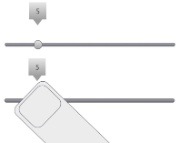A couple of weeks ago my fellow UX specialist Miranda de Groot and I visited Design for Conversion in Köln. Since we had already blown through the funds allocated for conferences this year we wanted to keep it as cheap as possible so we booked rooms at a F1 hotel in Frechen and went by car.
 I thought F1 would be bad but I had no idea how bad. Especially since other colleagues who had stayed in a F1 during their studies said things like "het valt best wel mee, hoor!" (trans. it's really not that bad). But man! it was bad. The interior decorators must have been inspired by cruise ships from the Soviet era and cleaning certainly wasn't high on the priority list.
I thought F1 would be bad but I had no idea how bad. Especially since other colleagues who had stayed in a F1 during their studies said things like "het valt best wel mee, hoor!" (trans. it's really not that bad). But man! it was bad. The interior decorators must have been inspired by cruise ships from the Soviet era and cleaning certainly wasn't high on the priority list.
 So after a night of of uneasy sleep in Frechen we packed our things and headed into Köln and the conference. Funnily enough: the same truckers that sat outside de entrance when we had arrived where (still?) sitting there when we left.
So after a night of of uneasy sleep in Frechen we packed our things and headed into Köln and the conference. Funnily enough: the same truckers that sat outside de entrance when we had arrived where (still?) sitting there when we left.
 The venue was really cool, it was located under the main railway line and reminded me a lot about the clubs I used to frequent when I lived in Berlin.
The venue was really cool, it was located under the main railway line and reminded me a lot about the clubs I used to frequent when I lived in Berlin.
The conference itself was an "unconference" which in this case meant that there was a mix of presentations and team based work. We were divided up into nine teams to work on cases for either Xing, Greenpeace or Coop (three teams per case). Miranda got to work on a sign in form for Green Peace and I got to work on how Coop Switzerland could improve the communication of their corporate sustainability.
Here are our take aways from the conference part:
Kath Straub (Usability.gov) - Persuasive technology, design beyond the task
Twitter: @kas
- The car sales man is a good intuitive psychologist in that he/she will try to find your trigger points by asking the right questions.
- Persuasion is often about finding an emotional hook like Coco pops saying that they help your child's immune system.
- Use a conversational tone of voice because it simulates an authentic conversation (like a time keeping system that says you have done good when you fill in your report).
- Persuasion and usability can be conflicting for instance a lotterty ticket is an example of a persuasive but hardly usable design. But it doesn't mean that usability doesn't matter.
- We need to make sure that we integrate our different communication channels such as email, web and twitter. Kath uses the example of an airline that emails you asking if you want them to check you in for a small fee.
- Through the social media space we have access to "similiar strangers" which are people that we don't know but have the same experience or same problems and we will use their experience when making our choices.
- Don't forget about usability! If they can't use the product than persuasion doesn't matter.
Peter van der Putten (PegaSystems) - Authenticity a left brain approach
Slides: Authenticity a left brain approach
- Be authentic. If you have have a system with a greeting when the user logs in then make sure you get the name right (reminds me about the rule about not breaking the fourth wall).
- Be one. Make sure you have control over the user experience across your different channels.
- Authenticity is about being reliable and trustworthy like when the neighborhood butcher would remind you if you forgot to by eggs that day.
- Avoid the uncanny valley (odd use of the term, normally it's used about humanoids) but what Peter meant was that you don't want to get to personal and exoid because it's experienced as uncomfortable.
Nicholas Mohr (Sapient Nitro) - Using data to improve online experiences
Slides: Using data to improve online experiences
- Web Analytics is hot with Coremetrics and Unica being bought by IBM and Omniture being bought by Adobe.
- Web analytics is about getting a competitive advantage by looking at what has happened, why it has happened and what is going to happen.
- Web analytics should drive strategy by helping you to understand customers, get business intelligence, uncover gems, drive/help marketing efforts and innovation.
- Web analytics needs to be used with methodology otherwise you will only be able to figure out what has happened but never why.
- A/B-testing is a good start is not enough. Nicholas compares it to sandpaper, it smoothes out small bumps.
- User experience is about observation, understanding modeling and innovation and in the understanding phase web analytics data should play a major role.
- Web analytics needs to be used for continuos improvement of existing web sites by measuring performance based on the KPIs.
- To improve the online user experience you need to use web analytics to identify issues, use usability testing to understand why, validate the fixes by e.g. multi-variate testing and use web analytics to optimize.
Paul Hughes (Lava Design)
Twitter:@paulbhughes
 Paul easily held the coolest presentation. He did not use PowerPoint but instead he drew his presentation on a roll of butcher paper. The drawing was filmed an projected on a screen behind him.
Paul easily held the coolest presentation. He did not use PowerPoint but instead he drew his presentation on a roll of butcher paper. The drawing was filmed an projected on a screen behind him.
Much of what Paul said falls into the category inspirational but here where some concrete tips such as that there are three levels of design: components - the form and function, connections - the system and the processes and context - the strategy and the policy surrounding it. He used Apples media strategy and Philips work on hospitals to exemplify. In Apples case the iPod is the component, iTunes the connection and redefining personal music the context. Good design should be about all three.
However I have my doubts about his examples. Much of the innovation that we see around us are driven by chance and not by strategic thinking (Apple bought SoundJam years before they released the iPod). In the medicinal world Viagra and Rogaine are examples of successes that came to light by chance. Both where developed for the treatment of heart disease but alternative uses came to light when patients refused to hand in their left over pills when the clinical trials ended. But regardless of the serendipity factor he has a point about looking at the broader context and not just the function of a product.
Paul also talked about branding and how it is important that actions and communication happens in parallel in order to establish trust.
Cases, competition and Coop Switzerland
 Each of the three sponsors had brought a case and we got divided up into nine teams to work on them, three teams per case. At the end of the day there was a presentation round and a semi-finalist was chosen per case. Those three teams then went to the finals where a winner was chosen by the sponsors. My team won and I we each got a mug with "member of the winning team" printed on it.
Each of the three sponsors had brought a case and we got divided up into nine teams to work on them, three teams per case. At the end of the day there was a presentation round and a semi-finalist was chosen per case. Those three teams then went to the finals where a winner was chosen by the sponsors. My team won and I we each got a mug with "member of the winning team" printed on it.
 My team worked on a case about how to improve communication about corporate sustainability at Coop Switzerland (funnily enough their representative was a Swede who had grown up in Switzerland). Their problem was that there was a myriad of certifications and marketing campaigns but they where unsure about how they where perceived as a brand and they did not have any marketing research data (at least not with them).
My team worked on a case about how to improve communication about corporate sustainability at Coop Switzerland (funnily enough their representative was a Swede who had grown up in Switzerland). Their problem was that there was a myriad of certifications and marketing campaigns but they where unsure about how they where perceived as a brand and they did not have any marketing research data (at least not with them).
 We developed a concept where consumers could earn points and badges through making sustainable choices when they shopped. All of this was backed up by a status transition system, tracking and the ability to cash in the points earned. We began with a brainstorming session where we wrote concepts down on post its. The post its where then clustered and we choose a cluster of post its as basis for our concept which we then worked out on paper.
We developed a concept where consumers could earn points and badges through making sustainable choices when they shopped. All of this was backed up by a status transition system, tracking and the ability to cash in the points earned. We began with a brainstorming session where we wrote concepts down on post its. The post its where then clustered and we choose a cluster of post its as basis for our concept which we then worked out on paper.
Sadly, Miranda wasn't so lucky when it came to the cases. She got to work on how to persuade people to sign a multi-page form for Green Peace. That wouldn't have been so bad if it wasn't for that one of the constraints was that they weren't able to change the form, only the surrounding pages.
Check out videos of the speakers and the case presentations.



























